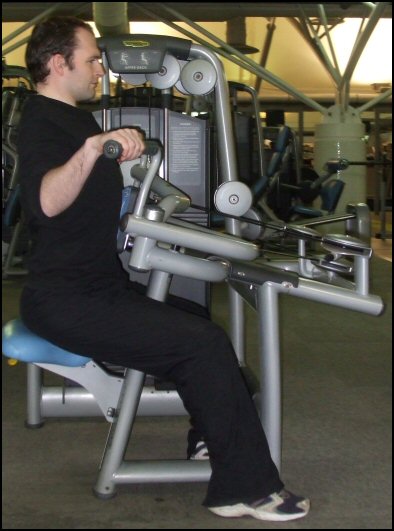Static Contraction
An Introduction to Measured Isometrics
By Paul "Batman" O'Brien
B.A., N.C.E.H.S., Dip. Acu., Cert Clin. IMed., Dip. Adv. OBB, Dip. CHM, Pn1, PN-SSR, PN-NCA, M.AFPA., M.C.Th.A.
Static contraction is a form of Isometric Training. However it is generally more associated with Isometrics against some form of resistance, for instance a large weight stack. The majority of the exercises used in static training and large compound movements.
Static's can produce wonderful increases in strength and muscle when used correctly,
This can be an excellent way to test isometric strength and the products of Isometric Training.
However it is NOT a method I would recommend....at least not for most...read on though and I'll tell you why and when you should use it for maximal results.
You see there are a few problems with the popular static's method. Firstly it's not true Isometrics.
The above image shows the WRONG WAY to do a static Upright Row. The hands are far too high. Learn the right way to train at www.IsometricMastery.com
There is often some small movement in Static Contraction Training...which, by its definition then, means it's a sub-maximal form of training. Even if you can lift and enormous weight a few inches off the bar it's not your maximal level of resistance. You could after all move it those few inches. ;-)
In addition many of the Static isometric methods popular on body building forums have serious flaws in their overall methodology. There are WAY too many errors and on top of that serious health risks concerned with program.
The introduction of weights with isometrics is a dangerous thing - it can produce remarkable results and I can show you how to that safely, BUT done wrong, with the wrong principles and wrong methods can cause catastrophic life altering injury and even death.
The 3 Problems with Static Contraction
Static's, in so far as it as training methodology using isometric tension after a strong range partial has a number of problems;
1) Structural alignment - sadly most people using this method are poorly trained in using weights and weight lifting technique and even those these are heavy range partials - given the vast weight being used it's critically important that proper structural alignment is adhered to.
For example, if we take the bench press - often times participants have the elbow joint misaligned with the wrist which results in massive medial compression of the carpals (wrist bones) and can lead to nerve damage, joint damage and pain. If the arm's and elbows are misaligned there is good choice that the latissimus dorsi won't be contracted and as such the shoulder joint will be out alignment - this leads to serious damage of the rotator cuff, leading to bursitis, osteoarthritis, compression damage, frozen shoulder and even possible dislocation.
In the next article in the series I'll share with you the other 2 problems with statics and then, the solution!
You've been reading about Static Contraction. Check out the next part in this series - The 3 Problems with Static Contraction Training here.









New! Comments
Have your say about what you just read! Leave me a comment in the box below.